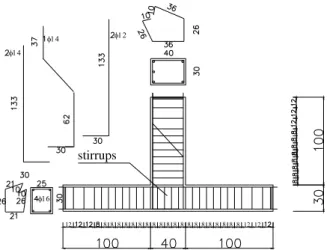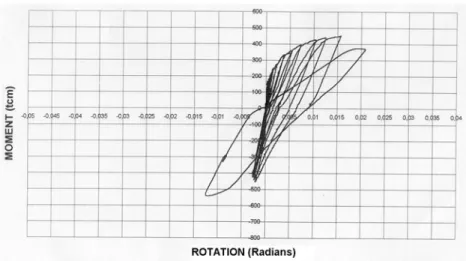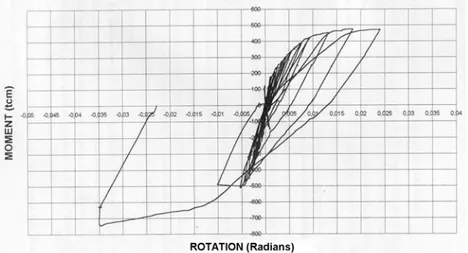THE EFFECT OF STIRRUPS AND HOOKED STEEL FIBERS INSTEAD ON MOMENT-ROTATION CAPACITY OF BEAM-COLUMN CONNECTIONS
Assist. Prof. Dr. S. KamilAkın1, Assist. Prof. Dr. Nail Kara1,
1
Department of Civil Engineering, Selcuk University, Konya, Turkey.
Abstract
In earthquakes the energy should be dissipated by structural elements. The energy concentrated in beam-column connections and the earthquake loads forces the connections to rotate. As a result of this, the connections should have the ability of rotation without reduction in axial load capacity of columns. The concrete in the connection zone should not break, collapse and should stay stiff for no reduction in the load bearing capacity of connection. Because of this all codes forces design engineer and constructor to continue stirrups in beam or column without break in the connection. While application of reinforcement according to the design in construction stage , to put stirrups in connection is very hard and takes a lot of time also it is very hard to concrete this region also.
This study concerns with the use of hooked steel fibers instead of stirrups in beam column connections. Recent studies made clear that , use of steel fibers increase ductility, stiffness and toughness in concrete[1] [2] [3] [4]. In this study 5 beam-column connections are tested under cyclic loading. First specimen has stirrups in connection zone according to code, the rest have no stirrups but have hooked steel fibers instead in connection zone with varying volumetric ratio 0,000%, 0,250%, 0,375%, 0,500%. The specimens are tested in Selcuk University Civil Engineering Department Structural Laboratory. Earthquake loads are simulated on the 1/1-scaled specimens and all vertical and horizontal displacements are taken by a dozen of LVDT and this data is sent and saved by the help of an electronic device and computer program. The experimental moment and rotation capacities are found and compared.
1. Introduction
The main ideas of codes are to have rigid, strong or ductile members. The design should have one of the previous characteristics.
Turkey is on Alp earthquake region, where earthquakes often occur and the earthquake resistant designs have vital importance. The last earthquakes showed that the damages are sometimes because of project and unsatisfactory material properties but often because of construction out of project.
The studies showed that the main mistake made in these types of structures is, not to continue stirrups in beam or column although it is forced by the building code. The stirrup put in connection region encircles concrete and not let it to collapse easily and give ductility to the connection and this enlarges the energy absorption capacity also. The earthquake forces concentrates in the connection region and forces the connection to rotate. The connection should have the ability of rotation without damage. If the concrete in connection region collapses the axial load capacity of the column suddenly decreases and the structure losses axial load bearing ability and collapses easily. The codes prevents this by having a plastic hinge in the beam on the surface of the column.[5] This protects the column from damage a lot.
Studies on steel fibers made clear that it is really hard and takes time to put stirrups in the connection region; on the other hand concreting this region is also very hard too. As a result to prevent from these and make it easy, in this study five 1/1-scaled beam-column connection having stirrups according to code, and having hooked steel fibers having 0,000%, 0,250%, 0,375%, 0,500% volumetrically are tested under simulated earthquake loads. The results of the tests are analyzed and the effects of steel fibers on the rotation capacity of connections are made clear.
2. Properties of Used Materials
Properties of normal aggregates: The normal aggregate used in this study is obtained
from Göçü sand quarry in Konya. The aggregate obtained from Göçü sand quarry has dense unit weight of 1730 kg/m3, loose unit weight of 1455 kg/m3 , water absorption ratio of %8. For normal concrete, using Göçü sand there is made comparison with the suitable granulometric regions given in TS802 and appropriate ratios are found .[6]
Cement Properties: In this study portland cement with additives (KPÇ 325) produced
by Konya Cement Factory, having 3.15 kg/dm3 unit weight is used .[6]
Properties of Mixing Water: The mixing water used in the study is obtained from
Selcuk University Campus and it can be used as drinking water.
Properties of Concrete: Grain size distribution is same for all concrete’s. In mix design
absolute value method is used. As in the code 350 dosage for concrete (C20) having W/C=0.50 is used for the connection samples.
Properties of Reinforcing Steel: The reinforcement used in the study is S420 and
suitability of reinforcement is tested for TS 500 and TS 708. The same reinforcement details are used for normal and lightweight concrete beam specimens. The reinforcement used in the samples has the same type and radius for the specimens. The mechanical properties of reinforcing steels are given in Table 1.
Table 1. The mechanical properties of reinforcing steels Sample No Diameter of thought (mm) Diameter of found (mm) Crossectio nal area (mm2) σyield (kg/cm2) σcrack (kg/cm2) εcr ack % 1 12,0 12,1 114,93 4232 5374 25 2 14,0 14,1 156,07 4327 5417 23 3 16,0 16,2 206,02 4524 5545 21 Average 4361 5445 23
Properties of fiber concrete: Fiber concrete can be stated by ACI [1] as the mix of
hydraulic cement, aggregate and fibers often separated non-continuously. ACI also states that the most suitable numeric parameter to classify fibers is ‘length (l)/diameter (d) ratio. The hooked fibers have 60/0.80 l/d ratio and tension strength less than 1700 N/mm2. The hooked fibers are glued to each other and after adding to concrete the glued fibers separated from each other and mixed non-continuously in the concrete.
3. Concrete Production and Curing
The concrete is produced in Selcuk University Structure Laboratory. No additives used for concrete production. The smples are cured for 14 days to have construction site
stuations. Steel Plate molds are used as molds for specimens. The f cr of concrete
obtained from φ15/30 moulds are given in Table 2. Table 2. The f cr of concrete used for specimens
Sample No 7 day f cr (kgf/cm2) 28 day f cr
(kgf/cm2) 1 143,6 215,0 2 145,0 218,0 3 144,0 212,0 4 144,5 220,0 5 144,0 210,0 Average 144,0 215,0 4. Experimental Program
The experimental model to search the behaviour of a beam-column connections is given in Figure 1 and the schematic wiev of LVDT Placing is given in Figure 2.
N P h/2 P h/2 N L/2
Figure 2. Schematic View of LVDT’s
5. Test Models
Five different test specimen are used to determine the behaviour of connection with stirrups and fibers of 0,000%, 0,250%, 0,375% and 0,500% volumetric ratios. The connection model details with stirrups is given in Figure 3 and the connections without stirrups are given in Figure 4.While loading thick steel plates are attached to column and beam ends.
12 8 8 8 8 8 8 8 8 8 8 8 88 8 8 888881212
stirrups φ14
φ14 φ12
φ16
12 8 8 8 8 8 8 8 8 8 8 8 88 8 8 888881212
φ14
φ14 φ12
φ16
Figure 4. Connection without stirrups.
7. Test Results
Obtained Moment-Rotation Graphics obtained under cylic loading are given in Figure 5, 6, 7, 8, 9. The columns are under 25 tons of loading.
Figure 6. Moment-Rotation graphics for sample having 0,000% fibers
Figure 7 Moment-Rotation graphics for sample having 0,250% fibers
Figure 9 Moment-Rotation graphics for sample having 0,500% fibers
8. Conclusion
Experiments showed that added fibers instead of stirrups made the connection much more ductile and this cause enlargement in the rotation capacity of the connection. The load bearing capacity of the connection doesn’t change a lot. For the sample having 0,000% fibers have limited rotation capacity and the concrete in the connection zone collapsed and after this the connection lost the load bearing capacity. In all specimens the plastic hinge occurred at the face of the column on beams as the codes wanted. As a result with much more studies comparing the connections with stirrups and fibers instead should be made to clarify the affect of fibers . From wives of rotation capacity it can be said that fibers can be used instead of stirrups on the connections.[7]
References
[1] ACI Committee 544 , State of The Art Report on Fiber Reinforced Concrete ACI Journal , November, PP 729-744, 1973
[2] Craıg R.John, Structural Application fo Reinforced Fibrous Concrete Concrete Internatıonal ,December , PP 28-32 ,1984
[3] Saraoushian P.,Bayasi Z., Fiber Type Effects on Steel Fiber Reinforced Concrete , ACI , March 1991
[4] Saraoushian P.,Bayasi Z., Fiber Type Effects on The Performance of Steel Fiber
Reinforced Concrete , ACI , March-April 1991
[5] Turkısh Code of Desing and Construction Properties ,1984
[6] Kaltakcı M.Y., Kamanlı M.,An Experimental study on flexural behaviour of
lightweight and normal weight concrete,PhD thesis ,1998,Selcuk University
[7] Kara N., Akın S.K., The Effect of Fiber Concrete on Bearing Capacity of Beam



